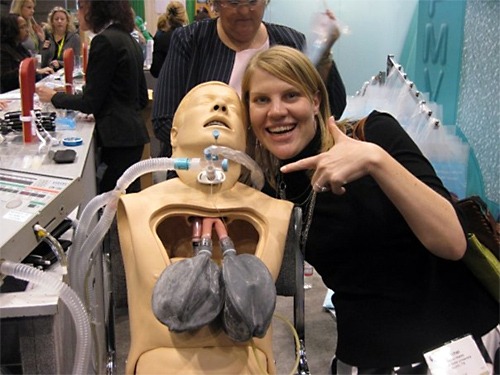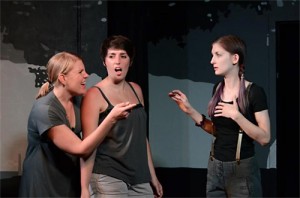
Almost a year after I received improv classes from my husband as a Christmas gift, I finally made it down to the Hideout for Level 1. The objective of Level 1, and I suppose many other introductory courses, is geared toward relinquishing a need to know everything before it happens, letting go of the idea that being in-the-moment is terrifying and learning to connect with people by having no expectations of them whatsoever. I found this exceptionally challenging. I also found the countless games we played were just like the work I did everyday: Speech Therapy.
There was the phonology game: Bibbity Bibbity Bop. There was the attention/memory game: Sound Ball. There was the narrative game: Story Spine. There was the Theory of Mind game: Gift Giving
It took an obnoxious amount of time to get out of my own head, to get out of therapist mode, especially after coming straight from work at a local Traumatic Brain Injury (TBI) facility. I made comments like, “This is what I do all day” and “OMG, I can’t believe how much this is like therapy!” Eventually I stopped being Rachel the Therapist in those three hours on Tuesday night, and I became Rachel the Improviser, but I started to carry a little bit of the improviser and improv into work.

Wednesday mornings I ran an Aphasia Group. I wrote the Story Spine on a dry erase board, and I used a stack of emotion cards to elicit the narratives. I reminded the group to stay “Happy Healthy” and sure enough the narratives flowed.
A few weeks later I used the same story spine in a large cognitive group; the result was astounding! The people who I thought would struggle performed exceptionally well, each person taking a turn to add a piece. It was my folks with Right Hemisphere Disorder and Executive Function problems that brought in responses out of left-field, who couldn’t tie it all together in the end. It was fascinating to see all the cognitive skills it takes to improvise elicit therapeutic breakdowns.
Then the biggest breakthrough of all. A young man at our facility had been initially placed in a more independent setting. He was younger than our average patient and was a sweeter, gentler kind of kid. He had been injured playing high school football and had suffered major damage to his short-term memory, comprehension of information, and was having a lot of difficulty putting the small pieces of the world together into one big picture. The world reset when he entered a new space, and to remember three words, he had to repeat them every minute for 20-30 minutes. If he walked away from those words, and I asked for them later, he would sincerely reply, “I’m sorry ma’am; I have no idea what you’re talking about.”
One Friday I decided we should play “Whoosh, Bang, Pow,” a game that challenges attention, shifting set (knowing when to apply certain rules at a specific time), and socially appropriate eye contact. It was hilarious and glorious at the same time. Our young friend had a hard time keeping up, but he would intermittently chuckle “I love you guys!”
Improv as Speech Therapy
Flash forward two weeks: our young friend has moved to a more supportive environment; he is beginning to remember which hallway his room is in, that he doesn’t have to be anxious about clocks. He is beginning to learn his therapists’ names and ask questions about his recovery.
We were in Opening Group. I suggested we play “Whoosh Bang Pow” to get everyone motivated as Thursday sluggishness has taken a serious hold.
“I know that game!” He exclaimed. My eyebrows shot up. “Yes, you do know that game. You played it at the other
campus… can you tell us the rules?”
“I’m sorry ma’am; I have no idea.”
“Well everyone will stand in a circle. We’ll start by passing a whoosh.”
“Whoosh!” His arms flew the left. I was shocked.
“What if I say ‘bang’?”
His arms crossed in front of his chest.
“And what’s last?”
“Pow!” and he threw a Pow across the room.
I was astonished. He had only been exposed to this game once before, in another setting, and he had recalled the details of the game with minimal prompts. Then it dawned on me. He was a football player. Whoosh Bang Pow was a pairing of verbal and kinesthetic movements. He was a “body learner,” and we now knew that he could retain novel information, store it in long-term memory, and shift set… this was an early indication about his recovery and prognosis and about which therapy methods would support his style of learning. It all started falling into place. New interventions, ways to help him learn how to safely finish high school, how to help him get his life back…
Pow!

Omg! Rachel! Sooo good!!! <3 also fascinating 🙂
Rachel, will you get in touch with me? I’d like to talk to you about your work and the center you work for. My email is at my website.
Julie
Julie – Rachel is currently in germany, but I can get you in touch with her. I’ll forward her your email. I know she’s checking it while she is away but not with normal frequency.
I think improv opened me up to being much more comfortable in my skin. My favorite part was the failure bow, I loved how it embraces and almost rewards making mistakes in interaction. I work in software, I’ve been finding ways to bring in what we learned to our workplace as well and allow us end up making better things that we are more proud! There is definitely a payoff bringing improv into the other parts of your life, huh?
This is so incredible.